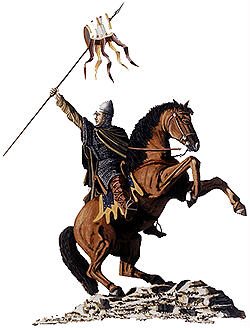
 Battle of Hastings
Battle of Hastings

The Battle of Hastings took place on October 14th 1066 and was fought between Harold, King of England and William, Duke of Normandy.
In 1051 Edward the Confessor had named William of Normandy heir to the English throne. When, in January 1066, it was taken by Harold, William was left with no choice but to take the crown by force.
He landed on the beach at Pevensey with about 7,000 Bretons, Normans, French and Flemish troops. Harold was in the north, having just won a great victory over the Vikings at Stamford Bridge when news reached him of the invasion. He hurried south to do battle.
|
Although he had gathered fresh men on the way, and had a similar number to the Normans, most were exhausted when they set up camp near the village of Battle in Sussex.
The Normans seized the opportunity, marched out of Hastings and took up positions on Telham Hill about a mile from Harold's camp.
William made the first attack and met with strong resistance. As the day wore on, fierce hand to hand fighting weakened the English. In the evening when William made his final attack, Harold was cut down by Norman swords and the Saxons were defeated.
The Battle of Hastings changed the course of history. It made England a closer part of Europe and for the next three hundred years, the rulers and the nobility of England spoke French, not English. Indeed, many nobles spent their lives on their French estates instead of in England. The Norman victory changed the way in which the country was ruled. Under the Saxons, the earls were often as important as the king, but now the king was firmly in control. He governed the whole of the country and his rule was law.
Today the village where the battle of Hastings took place is simply called Battle. The town of Hastings itself is about ten kilometres (Six Miles) to the south-east of the battlefield. Before the battle Duke William made a promise to God that he would build an abbey if he won. He carried out his promise. In Battle Abby the high alter of the church is said to mark the spot where King Harold was killed.
Saturday morning, 14 October 1066. On Telham Hill, in the distance, are knights on horseback carrying lances and javelins and gaily coloured banners.One knight in particular stands out. This is William, Duke of Normandy, the commander of the Norman army in front of you. Duke William is French, but he claims to be the rightful King of England. This is why he has landed in Sussex to fight the Saxon army.
In less than ten hours the fighting is over.
The house-carls were a small band of about 3000 skilled soldiers who made up the kings bodyguard. They fought on foot with long, heavy battle axes. These axes could split a man in two with one blow. The house-carl swung his axe behind the left-hand shoulder so that the blow hit the enemy on his unprotected right-hand side.
The house-carls wore hauberks for protection. These were coats of mail (armour) made by stitching wire rings together. They were extremely heavy.
|
 Return to the Fridge door
Return to the Fridge door